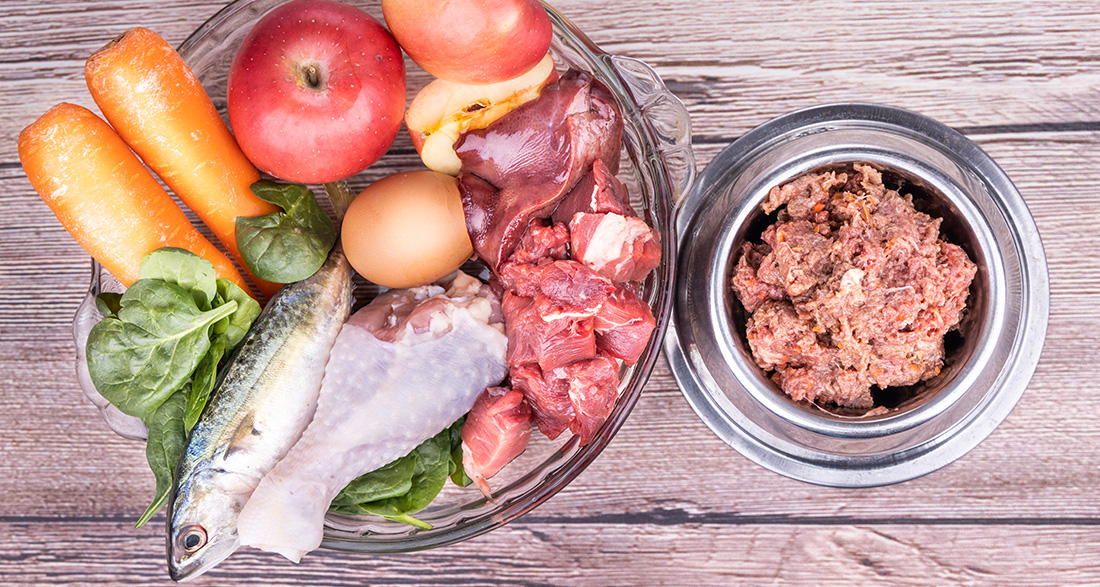Do you want to know more about barfing? How it works exactly and what you need to consider? What it costs and what equipment you need to start with? I’ll show you all of that in this comprehensive guide. So, stay tuned!
BARF stands for Bones And Raw Food for dogs & cats
What exactly is barfing?
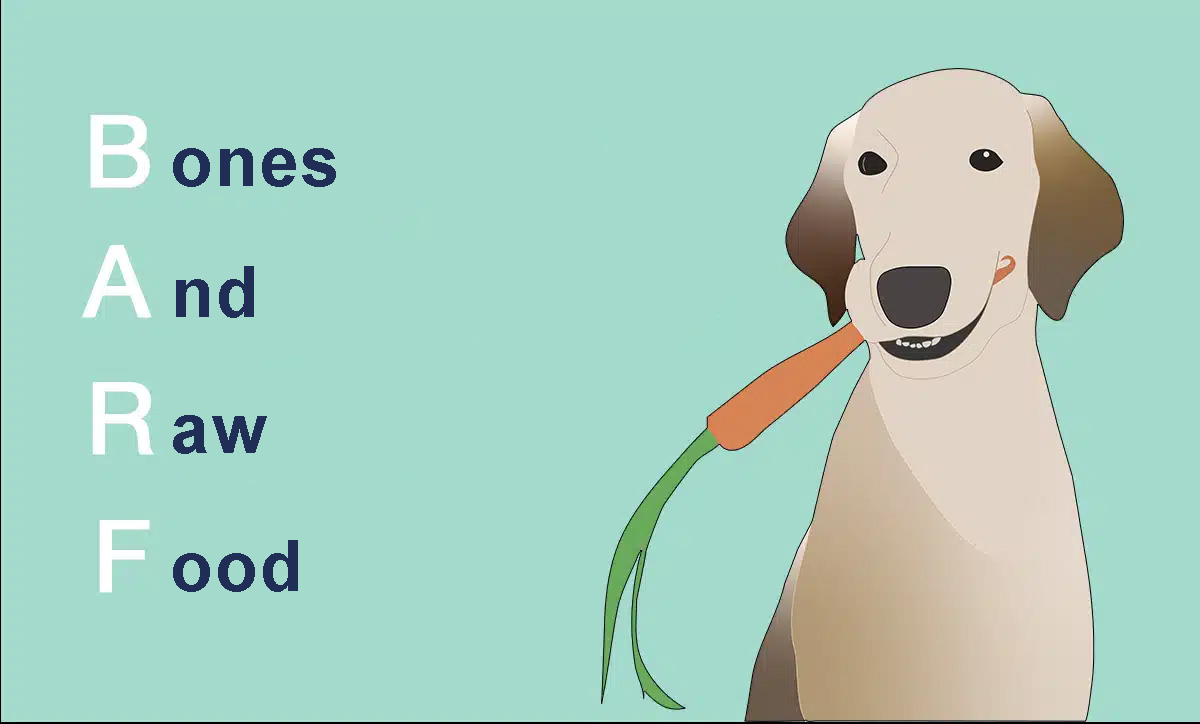
Although this method was originally developed for domestic dogs, it is also used for house cats today.
In this feeding method, the dog is fed only with raw meat, bones, vegetables, or grains.
…and what does BARF stand for?
The abbreviation BARF originally stood for “Born-Again Raw Feeders,” later for “Bones And Raw Foods.”
What’s the background? Our faithful friend is known to be descended from the wolf. Originally, it fed on raw meat, carrion, berries, and roots. The stomach of our quadrupeds is still very well adapted to a diet of raw meat.
Pros & Cons of Barfing (compared to wet or dry food)
Ideal for dogs with allergies and intolerances:
With barfing, you assemble all the ingredients yourself. So you can perfectly tailor them to your dog’s needs. If your dog reacts allergically to certain ingredients, you can simply leave them out and replace them with an alternative.
Fewer parasites:
Raw meat lowers the pH level in your dog’s stomach significantly. As a result, parasites like worms no longer find the necessary basis to feed.
Healthier teeth:
Dogs fed with industrially produced food often develop dental problems over time. Barfing, on the other hand, promotes optimal dental care through gnawing and chewing on bones. It helps prevent tartar buildup.
Stronger muscles:
Raw meat provides your dog with important nutrients. This promotes the development of its muscles.
Less bad breath:
Some dogs have an unpleasant mouth and body odor. Often, the additives in wet or dry food are responsible for this. Those who barf will notice over time that this strong odor diminishes or even disappears entirely.
Better stool output:
Barfing allows your dog to process and digest food more naturally. As a result, his stool volume usually decreases.
Lower risk of gastric torsion:
The actual cause of gastric torsion has not yet been clarified. However, it is suspected that the high proportion of grains in some dog food varieties could be a reason. Because the food swells in the stomach.
Some theories suggest that this stretching of the stomach favors the conditions for gastric torsion. In contrast, a well-balanced diet with raw meat and vegetables or grains takes up less space in the stomach and could thus reduce the risk of gastric torsion.
Over- and under-dosing of nutrients:
With barfing, there is a risk that the dog may not receive a balanced diet due to under- or over-dosage of nutrients.
Especially puppies and young dogs can suffer serious damage from malnutrition during their growth phase. For example, deformities in bone structure.
Risk of infection from resistant bacteria:
Especially in intensive animal farming, antibiotics are increasingly being used in high doses to prevent infections. However, this leads to bacteria becoming increasingly resistant. These multi-resistant bacteria can be transmitted to the dog and thus to humans through raw feeding. The fact that resistant bacteria live in the human gut does not mean that there is an acute danger. However, it can be dangerous if an infection occurs and treatment with antibiotics becomes necessary.
The Cost of Barfing
Even though barfing may seem expensive at first glance, it doesn’t have to be. There are always ways to buy high-quality ingredients at a fair price.
Barfing is not more expensive than high-quality organic dog food.
Also, consider that you no longer have to deal with the “treacherous” labeling of some pet foods. Time is money, too.
Below, I’ll show you a few examples and products so you can assess the exact costs.
Is Your Dog’s Health Suitable for Barfing?
Before you decide to barf, you should consult with your veterinarian or a nutritionist to rule out possible underlying conditions such as allergies.
If you have a chronically ill dog, you should seek advice from a specialist. In some cases, it is better to cook the food rather than feed it raw.
Barfing for Beginners
In the following sections, we’ll explain exactly how to create your barfing plan, how and where to store the ingredients, what basic equipment you need, and how to calculate the calorie requirements.
We’ll also discuss which foods are good and which are not, and how to transition your dog’s diet. Let’s get started:
For your dog to eat healthily and balanced, he needs all the necessary components of his prey, like his ancestor – the wolf. The wolf also feeds on fruits (e.g., berries) and vegetables.
So, the components of barfing are: muscle meat, offal, vegetables, fruits, bones occasionally. Also, fats, oils, and minerals. These can be added to the food.
Infographic Components of Barfing
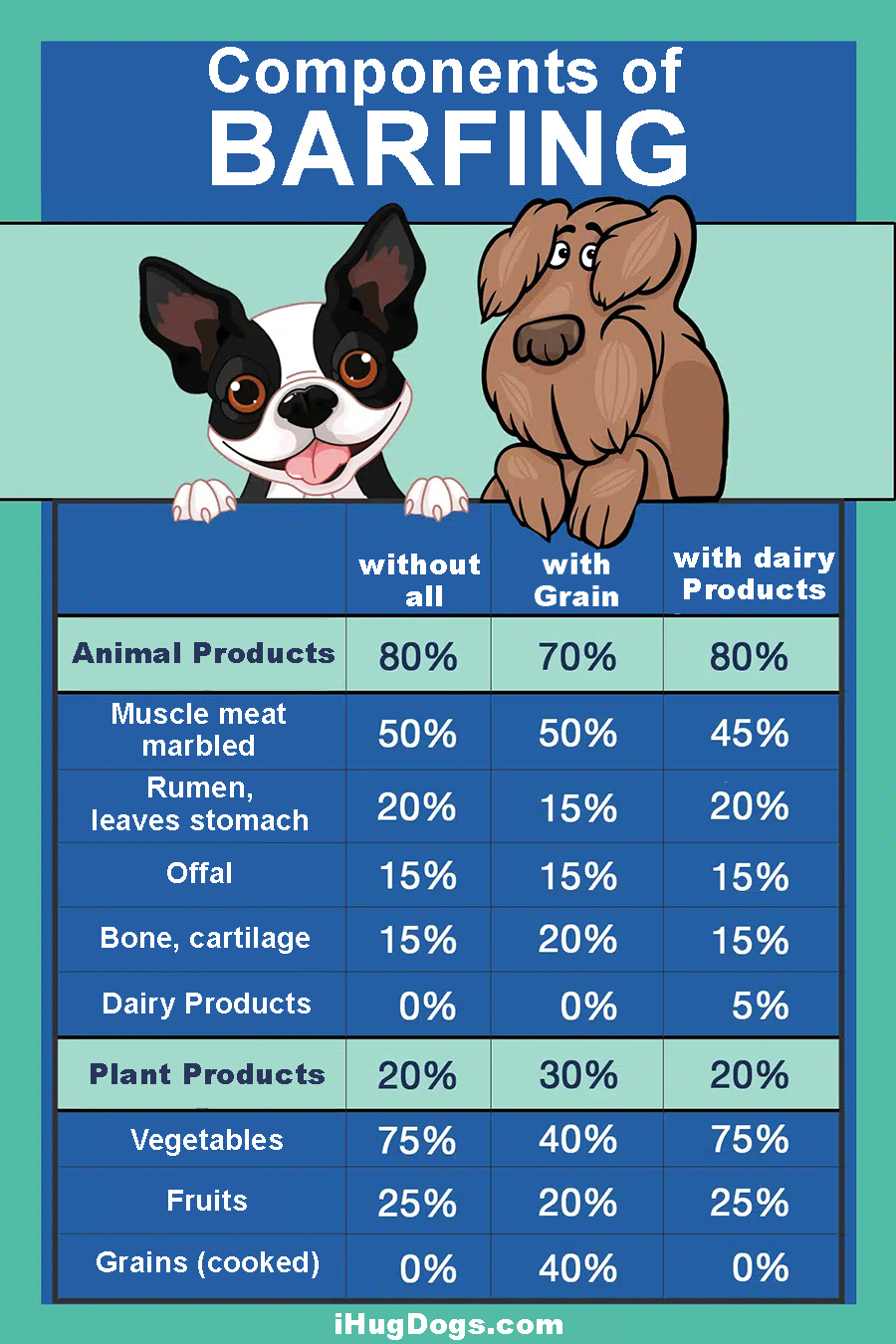
Components in %
Without grains:
| Animal products | 80% |
| Muscle meat, marbled | 50% |
| Rumen, leaves stomach | 20% |
| Offal | 15% |
| Bones, cartilage | 15% |
| Plant products | 20% |
| Vegetables | 75% |
| Fruits | 25% |
With grains:
| Animal products | 70% |
| Muscle meat, marbled | 50% |
| Rumen, leaves stomach | 15% |
| Offal | 15% |
| Bones, cartilage | 20% |
| Plant products | 30% |
| Vegetables | 40% |
| Grains | 40% |
| Fruits | 20% |
Please note in the composition of the ingredients that the fat content is balanced. It should be between 15% – 25%. With increased activity, it can be higher than 15% but should not exceed a maximum of 25%. Otherwise, your dog’s pancreas may be overwhelmed or he may suffer from obesity.
For growing dogs, the fat content should be around 15%. Excessive energy intake leads to faster growth, which can lead to health problems in later years.
Also, pregnant or lactating dogs should receive more fat. Conversely, dogs with, for example, a pancreatic disease should receive less fat. In such exceptional cases, it is always advisable to discuss this with a knowledgeable nutritionist or your veterinarian beforehand.
By the way, you can calculate the optimal fat value with a Fat Calculator for Dogs.
It is important to note that the values and recommendations given here are general guidelines for adult healthy dogs. If your dog has a chronic illness, we recommend consulting with your veterinarian.
How Should I Schedule My Time?

The more dogs you have, the more time you’ll need. Also, potential illnesses can burden your schedule at the beginning, as you’ll need to consider other factors too.
For a small dog, you naturally need much less time than for a large one. Therefore, it’s best to take plenty of time at the beginning.
Please also consider that portioning will initially take more time until you can “serve” your beloved pet its food. This can take up to two hours.
With increasing experience, you’ll gradually get the hang of it. So, it’ll become quicker!
Where and How Should I Store the BARF Ingredients?
You can store the ingredients in portions in resealable bags, vacuum bags, or freezer containers. After thawing, freezer containers can also be used directly as bowls.
In general, the same rules apply for storing as for meat or food for personal consumption. Meat should be stored cool and taken out of the refrigerator shortly before processing.
Frozen meat should be thawed in the refrigerator for a day.
The Federal Veterinary Chamber recommends feeding fresh meat only after sufficient heating (158°F (70°C) core temperature for 5-10 min.) or after at least 4 days of deep freezing at -4°F (-20°C).
Please be sure to observe hygiene and temperature regulations! Especially on hot summer days!
Basic Equipment

Sufficient Storage Space:
You should have enough space for the ingredients in the refrigerator or freezer. It might be useful to purchase a new or used one.
Scale:
For portioning the ingredients, you’ll need a manual or digital scale. It would be useful if the scale also displays gram amounts. You’ll need it to weigh the supplements (like oil, seaweed meal, etc.) accurately.
Sufficiently Large Bowl:
You’ll need a larger bowl than usual. The meat and ingredients require much more space than wet or dry food.
Sharp Knife:
You need well-sharpened knives to cut the meat properly. Also, note that you’ll occasionally need to split bones. You can get advice on this from your butcher.
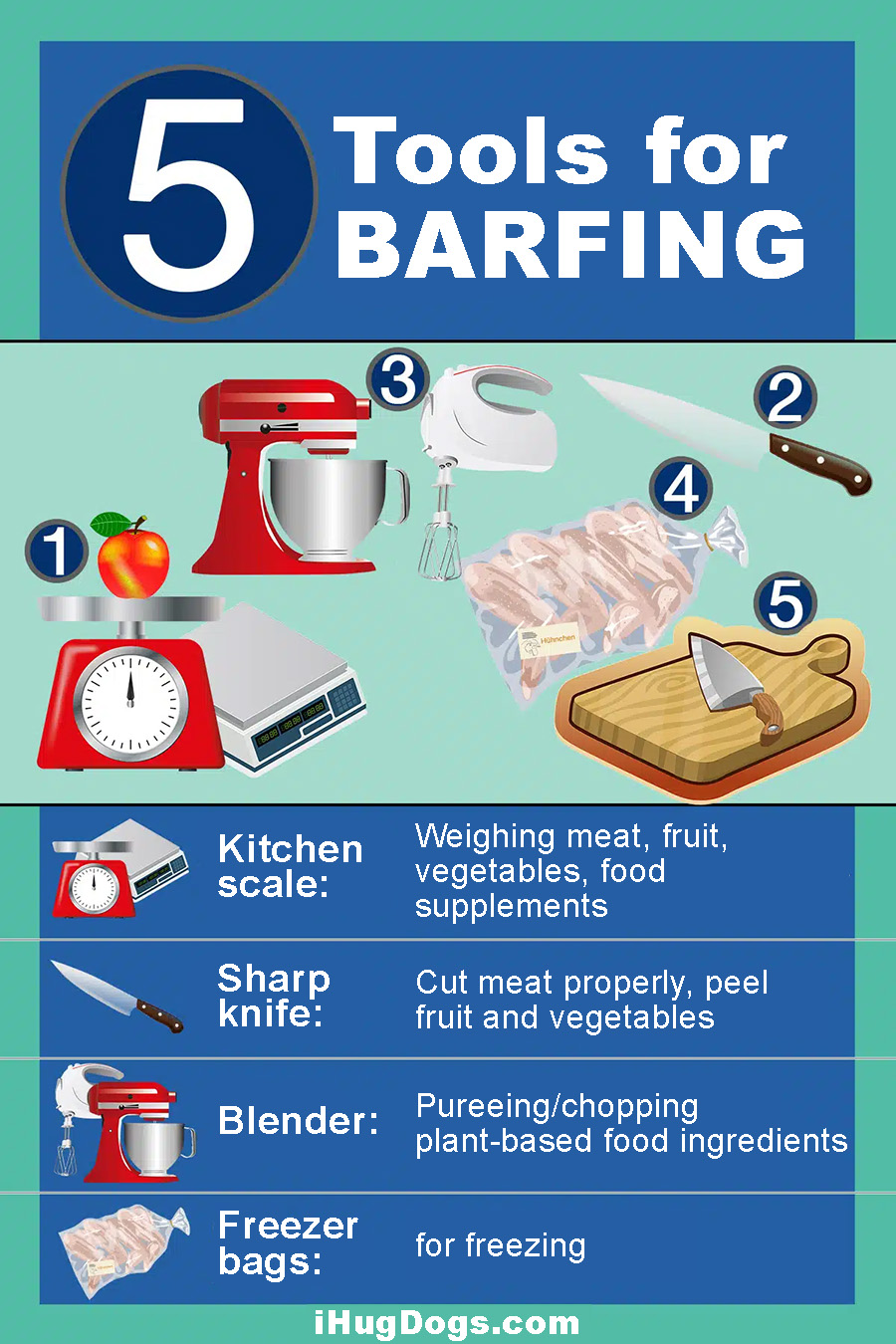
Calculating the Barf Quantity Yourself
Not sure how much your dog needs? Luckily, it’s not so difficult with barfing. Below you’ll find the formula for how much meat per kilo your dog needs.

The basic food requirement measured by body weight:
- adult dogs: about 2 – 4%
- large dogs: about 2 – 3%
- small dogs: about 3 – 4%
As an example:
- Body weight of a large dog: 55 kg
- 2% → 55 * 2/100 = 1.100 kg
- 3% → 55 * 3/100 = 1.650 kg
The basic requirement of a 55 kg heavy large dog thus lies between 1.100 kg and 1.650 kg.
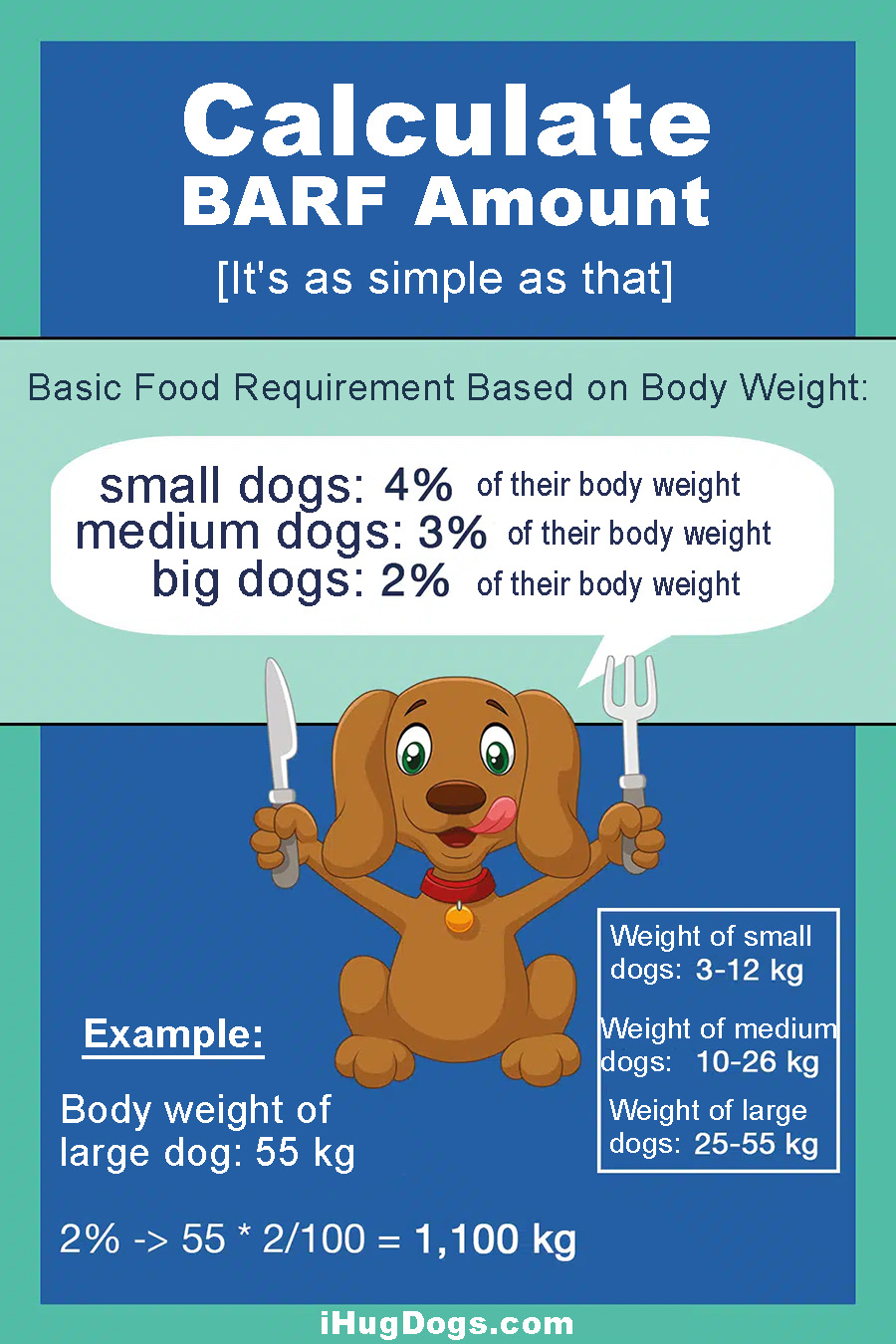
More on this topic can be found in our article “How to Calculate the Right Amount of Food for Your Dog“.
Please Note When Buying Meat
Just like with us, it’s healthier for your dog to get high-quality organic meat. With high-quality meat, the breeder avoids unnecessary medications like antibiotics and relies on pasture-raised animals.
This naturally also affects the quality of the meat. As a result, the nutrients are much more balanced and can be absorbed directly by your dog.
For small dogs, packages of about 200 grams are sufficient. It’s cheaper for you to buy larger packages and then portion them accordingly at home.
There are now also barf specialty shops that deliver food in convenient sizes. You can then store these in the freezer and thaw them individually as needed.
What Contents Belong to Barfing?
Muscle Meat:
Muscle meat, besides water and fat, also contains essential minerals and proteins.
- Beef is the perfect solution to start with. It has many proteins and is not excessively fatty.
- Turkey/poultry and rabbit are lean and easily digestible types of meat.
Important Note on Salmonella Risk:
Dogs have a very short digestive tract and can therefore digest raw food relatively quickly. The pathogens are excreted again before they can cause illness. A salmonella infection is primarily a problem of the dog’s immune system.
However, if there are individuals with weaker immune systems such as children and older people living in the same household, raw poultry meat is not recommended. Even though dogs can tolerate salmonella without problems, there is a risk of transmission to humans through the oral mucosa.
In general, especially when feeding raw poultry meat, not only should hygiene rules for the preparation and storage of the meat be observed, but it is also highly recommended not to allow the dog to lick your mouth, for example. Hands should also be washed thoroughly more frequently.
Innards:
Contain a lot of iron, copper, biotin, vitamin A, and B.
- Beef liver contains a lot of vitamin A. Do not give too often, as an overdose of this vitamin can lead to health problems.
- Beef blood contains many vitamins, minerals, and trace elements.
- Beef kidneys are rich in protein.
- Beef udder is fatty and calcium-rich.
Rumen:
Contain pre-digested plant substances. These promote your dog’s digestion. Beef rumen is best here. If your dog should be allergic, you can also try lamb rumen. More about this in our comprehensive rumen guide.
Bones:
Are optimal for dental care. They contain iron, fat, enzymes, and calcium.
Rib bones from beef, veal, lamb, rabbit bones, and deer bones with fur should always be fed raw to prevent splintering!
Fish:
Contain fatty acids, iodine, and various vitamins. However, it also contains enzymes that split vitamin B1. To avoid a vitamin B1 deficiency, you should feed your dog fish only once a week.
By the way, four-legged friends have a preference for salmon, herring, mackerel, and smelt.
Dairy by-products:
Some dogs cannot tolerate lactose in milk. Therefore, it would be better if you would opt for yogurt, cottage cheese, and quark, for example. Dairy products contain a lot of calcium and protein. Feeding your dog with some of these products from time to time is very sensible.
Eggs:
In general, it is recommended that the egg white should not be in the bowl. With too frequent feeding of it, there can be biotin deficiency symptoms such as dull fur, skin problems.
Egg yolk, on the other hand, is rich in vitamins, fatty acids, and trace elements. You can also mix eggshells into your dog’s food. They are rich in calcium.
You can give your dog 2 to 3 eggs per week.
Oil:
Oils can supplement your dog’s diet. They are responsible for releasing fat-soluble vitamins from food. They also contain linoleic acid and alpha-linolenic acid, which your dog’s body cannot produce itself.
They promote the nervous system, brain development, eyesight, fertility, skin condition, and ensure an intact immune system.
We can really recommend salmon oil, hemp oil, or pumpkin seed oil for dogs.
The oil should always be cold-pressed. Otherwise, these acids are destroyed.
Fruits and Vegetables:
Dogs cannot break down the cell walls of plants. Therefore, you should always puree the vegetables or fruit. Also, make sure that the vegetables or fruit are ripe or overripe.
You should always remove the cores from large and medium-sized fruits before pureeing them. The cores contain hydrocyanic acid, which is very toxic to your dog.
Always add a little oil to the vegetables or fruit. Because many of the vitamins contained are only fat-soluble. Your dog cannot absorb these in his body without oil.
Grains and Carbohydrates:
If your dog consumes a lot of energy and should lose weight with a normal portion without grains, you can replace up to 40% of the vegetable/fruit content with 40% grains.
If your dog has a gluten allergy, you can mix in rice, millet, amaranth, and oatmeal. These are all gluten-free.
As an addition, sea algae or sea algae meal makes sense for the barf diet. Since in most cases your dog cannot absorb enough iodine through diet alone.
What Contents Are Absolute No-Gos?
Raw Pork:
The Aujeszky virus contained in pork can lead to a deadly pseudo-rabies in dogs. Therefore, do not give your beloved any pork products such as ham, salami, etc.
Larynx meat and thyroid tissue:
The hormones contained therein can throw off your dog’s thyroid balance.
The Federal Veterinary Chamber recommends that fresh meat be fed only after sufficient heating (158°F (70°C) core temperature for 5-10 minutes) or after at least 4 days of freezing at -4°F (-20 °C).
Toxic vegetables and fruits are:
- Avocado
- Nightshades (tomatoes, eggplant, raw potatoes, bell peppers)
- Legumes (beans, peas, soy)
- Onion & garlic
- Raisins
Please do not overlook that your dog is a carnivore. So, unless there are health reasons, you should not feed your dog a vegetarian or vegan diet.
Spices:
You should stay away from spices. Also, there is no need to add salt to the food. Your dog gets enough of it from meat and vegetables.
Chocolate:
Chocolate and cocoa contain theobromine. This substance can even lead to death in dogs with small amounts.
On the following page, you will find more foods that your dog should not eat: What can dogs not eat?
Transitioning to BARF
Although some dogs have no problems with the transition, it has proven to be beneficial to take it slowly. Some dogs can be more stubborn than others. Your empathy is also required here, as every dog is different.
So, be prepared for the first few days to be challenging for both you and your loyal friend. Once the “crisis” is over, your dog will surely thank you.
Also, please note that this is a phase in which your dog is “detoxifying.” Therefore, the following symptoms may occur: diarrhea, mucus in the stool, itching, skin problems, discharge from the ears and eyes, vomiting, or foul odor.
If the symptoms have not disappeared after three days, you should consult your veterinarian for advice. He can prescribe supplements for your dog to help him during the transition phase, for example, with digestion.
Note that your dog’s body needs time to adjust, especially if you have previously fed your pet dry food.
Transition Instructions
If your dog has been accustomed to conventional food for years, it may be that he initially has difficulties with the transition.
- Let your dog fast for 1 day. This way, your dog has enough time to completely eliminate the old food from his body.
- For the first few days, feed your dog light meats such as turkey, chicken, or lamb, lightly steamed vegetables. You can also divide the daily ration into several meals per day. If your dog does not immediately accept the raw meat, you can boil or fry it a little at the beginning. Watch your dog very closely. If there are no abnormalities, you can move on to the other ingredients, e.g., add another type of vegetable or mix in beef, rumen.
- Now you could try the innards. At the beginning, it is recommended to keep the portion small. Because some dogs need time to get used to innards. Again, boiling or frying is a temporary alternative for the transition.
- If everything goes well and your dog seems emotionally and physically satisfied, you can slowly add bones. You can also add bones as bone meal or grind the bones. The bones must be raw in any case.
Note that bones harden the stool and make digestion more difficult. Here, you should observe your dog very closely. Therefore, it is advisable to add softer bones at the beginning. You should definitely avoid harder bones during the transition phase.

How often can I feed my dog BARF?
Adult dogs should be fed BARF in the morning or afternoon and evening.
For certain conditions, it is better if your dog gets his meals several times a day. In this case, it would be advisable to discuss this with your veterinarian.
After feeding, your dog should rest for at least one hour. So no playing or going for a walk! Strenuous movements can cause gastric torsion, as the stomach is still full.
How should I observe the changes in my dog?
After the transition, you should observe your dog’s appearance and internal processes very closely.
Your dog’s body will go through a so-called “detoxification phase” in the following months. As mentioned earlier, the symptoms can be diarrhea, mucus in the stool, itching, skin problems, discharge from the ears and eyes, vomiting, or foul odor.
This detoxification process can take a long time depending on the symptom. You must persevere here! Your veterinarian can also prescribe some natural remedies to help your dog through the transition phase.
If symptoms such as persistent diarrhea or regular vomiting occur, however, you should contact your veterinarian to rule out other diseases or to seek early treatment.
With raw feeding, your dog may have less stool than usual. This is quite normal because he can now digest his food much better.
Important features
If your dog has white stool, it could be from the added bones. If white stool and/or difficulty passing stool persist, you need to increase the meat and vegetable content.
Does your dog have constipation? This could be due to the high bone content. Here, you can give your dog pumpkin flesh to help loosen it. Then let him fast until he has a bowel movement. If the constipation is too severe, seek your veterinarian immediately!
At the beginning, your dog may also have diarrhea. Here, you need to differentiate between watery stool and soft stool. Soft stool will normalize over time. If the stool is very watery or the diarrhea persists, seek your veterinarian!
Mucus around the stool occurs after a raw food transition. Dairy products can also cause this. It is advisable to refrain from feeding dairy products for a while. If the mucus around the stool persists despite the measures taken or does not subside at all, please consult your veterinarian!
Our BARF Conclusion
Even though everything may seem a bit complicated at first, you will quickly realize that with empathy and attentive observation, you will also master this hurdle.
Furthermore, the bond between you will grow. Your pet will enjoy it, feel completely comfortable, and stay healthy for a long time.


